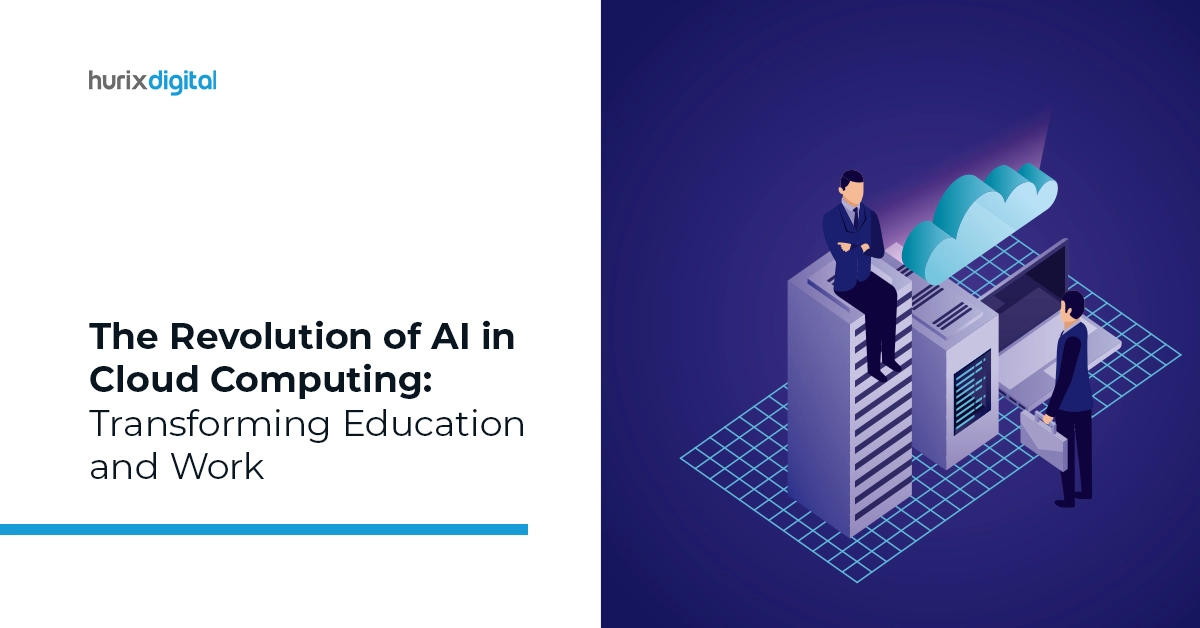The Revolution of AI in Cloud Computing: Transforming Education and Work
The potential of artificial intelligence (AI) extends beyond merely enhancing our lives; it has assumed roles as a teacher, assistant, and even a collaborator.
In the words of Google CEO Sundar Pichai, “In some ways, AI is like climate change and the planet.” Artificial intelligence has permeated every aspect of our existence, and the real-world applications are for everyone to see.
We’ve seen AI transform so many areas of our work — from medicine to finance to transportation — and wondered about the beginning of a revolution. It’s only going to accelerate in the years ahead.
Cloud computing is an indispensable part of this revolution. It is the technology that makes AI possible by providing vast amounts of data and computing power at scale. And it is making AI accessible to everyone, even those who don’t understand how it works or have the expertise to build their applications.
Table of Contents:
- AI in Cloud Computing: The Fourth Industrial Revolution
- How Is AI in Cloud Computing Transforming Education and Work?
- Wrapping Up
AI in Cloud Computing: The Fourth Industrial Revolution
As the global economy continues its descent into Industry 4.0, people seek new ways to excel in their careers and lives. The technological revolution will be cemented by advancements in AI and cloud computing — two of the most disruptive forces of our time.
The rise of AI technology has changed how we work daily. Transformation of work is due to enabling companies to use artificial intelligence to:
- Improve the customer experience
- Reduce costs
- Enhance employee performance
For example, when using cloud computing software, a business can analyze its data and predict future trends that will influence its sales or marketing strategies. This helps them make better decisions about how they can improve their services to meet the needs of their clients or customers.
Cloud computing has three main benefits:
- Easier to scale
- Build and deploy applications faster
- More cost-effective
These benefits of cloud-based AI are important because they help businesses stay competitive and adapt to market changes. The advances in AI and cloud technology, are transforming the way we work and learn.
AI can improve the productivity of workers by automating repetitive tasks, freeing up time for employees to focus on higher-level activities that require more human judgment. It is also making it easier for businesses to scale up or down based on demand.
AI cloud solutions are helping businesses create highly personalized experiences for customers by using analytics to collect data related to past interactions between customers and employees — such as phone calls, emails, and text messages — and then using machine learning algorithms to predict future actions based on those interactions.
This level of personalization can help businesses build stronger relationships with customers while also increasing revenue by helping them understand what they want from a business before offering products or services that are relevant to their needs.
Also Read: Everything You Need to Know About The Use of AI in Educational Assessment in 2023 and Beyond
How Is AI in Cloud Computing Transforming Education and Work?
Cloud computing is transforming the way we live and work. It’s no longer just about storing data but about using this data to make better decisions. And it’s not just about making better decisions for businesses but also for people.
The purpose of AI is not just to predict future events by analyzing data; rather, it aims at solving problems for which a solution already exists (or can be created), including automated decision-making and problem-solving.
High-impact companies like Google, Amazon, Microsoft, and Facebook are leveraging AI to improve their products and services. The same is true for universities and colleges.
1. Education
Cloud computing has been a game-changer for educational models, allowing them to operate more efficiently and flexibly. The same holds for AI.
As we see a proliferation of cloud-based applications across various educational services and platforms, it’s clear that AI is the next frontier for the educational sector’s growth. Here are the applications:
- AI can be used to improve the quality of education by providing personalized learning experiences
- Educators can create adaptive learning platforms to help students learn at their pace based on their unique needs and interests
- Learning can be improved by using data science and machine learning to assess student performance and provide feedback on what they need to study next
- It can also be used to enhance teaching quality by providing teachers with real-time data about their student’s progress
- AI can help teachers make better decisions about how best to engage them in a particular class
- AI can be used to help students improve their performance in the classroom and on standardized tests
- AI-powered tutoring systems can understand students’ needs better through multiple assessments and recommendations based on strategic insights
- It can also help teachers identify learning gaps so they can better tailor their lessons to individual students’ needs
- Teachers can use smart classroom technology, such as interactive whiteboards and digital content, to engage students in the learning process
2. Work
Cloud computing makes it easier for organizations to adopt AI because it provides access to large volumes of data through the Internet so that companies can train their models on real-world scenarios rather than simulations.
Here are the applications:
- AI-powered virtual assistants can help workers find relevant information quickly and efficiently
- It increases productivity and saves time for everyone involved — especially when it comes time for pay raises
- AI is not limited to academia alone; it has found applications in almost all industries today
- The healthcare sector uses AI for diagnosis, prediction, and treatment planning
- Automobile manufacturers use it for autonomous driving applications such as collision avoidance systems or lane assistance features that help drivers stay on track while driving long distances on highways or freeways.
- Law enforcement agencies are using facial recognition software to identify suspects from surveillance videos captured by cameras installed at crime scenes or public places like airports or train stations where crowds gather every day.
Also Read: Transforming Higher Education: How AI Is Changing the Education Industry?
Wrapping Up
AI and cloud computing are two of the biggest technology trends of the last decade. They’re both foundational technologies, meaning they need each other to exist.
AI is all about machine learning, which requires lots of data and computing power. Cloud computing enables the delivery of that data and those processors in a scalable way.
For those in pursuit of top-tier cloud services, Hurix Digital stands ready to assist. Hurix Cloud Services are versatile, accommodating various applications, including those designed for websites and mobile devices.
Schedule a call with us to know more about our work in AI and cloud computing space!

SVP & Head – Hurix Technology Solutions
Global Delivery head with 25 years of working experience in NYC investment banks and fintech companies. Hands-on technology delivery management and program management, accountable for stakeholder relationships, Strategic roadmap, P&L, Revenue growth, Account Management, and employee satisfaction.









